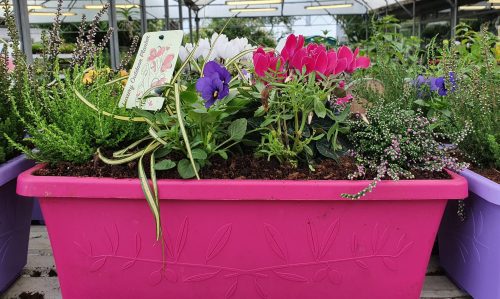-
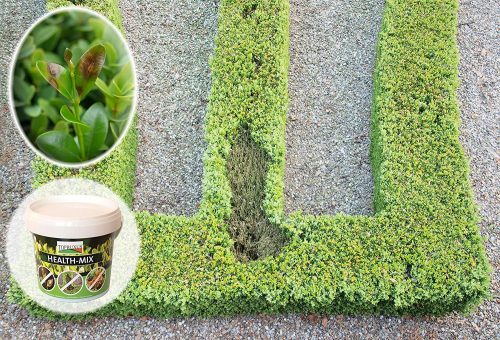
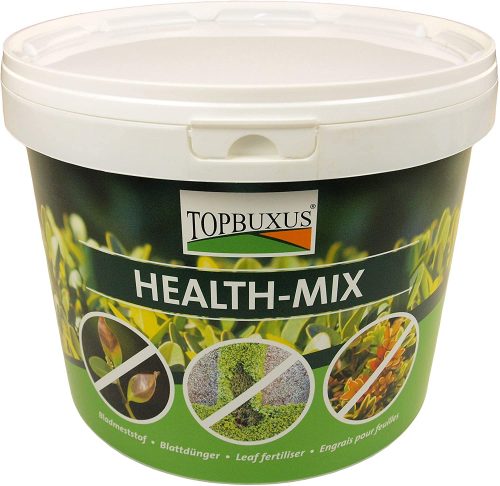 TOP BUXUS HEALTH-MIX can be used in two ways. 1. For bright green shiny leaves and to prevent fungal disease, such as Cylindrocladium With TOPBUXUS HEALTH-MIX, you can give your box plants bright green shiny leaves, preventing yellow edges and faded colours. To achieve this, treat your box plants 3-5 times during the growing season from March to October. This will also make your box plants healthier and stronger, resulting in them becoming more resistant to disease, etc.; this will particularly help to prevent fungal diseases such as Cylindrocladium. 2. To deal immediately with an acute fungal disease such as Cylindrocladium With TOPBUXUS HEALTH-MIX, you are able to immediately stop acute fungal disease such as Cylindrocladium. An acute fungal disease is immediately recognisable from the brown points that will swiftly expand to form blemishes. The most dangerous period is when there is protracted rainfall in combination with high temperatures. If you do nothing, the diseased box plant will soon start to lose its leaves and, in the worst case, if you fail to treat it, the affected branches can die, resulting in dead areas in your box plant. The diseased plants will then unfortunately have to be replaced. However, if you promptly use TOPBUXUS HEALTH-MIX after treatment, leaves will soon sprout on the diseased branches and recover. When the onset of disease is evident, immediately carry out the treatment. Under normal circumstances, one treatment is sufficient. It is extremely important to also immediately treat all of your healthy box plants. Should the warm and damp weather persist, repeat the treatment after 1 week. Thorough inspection is recommended in the future, particularly when the weather is warm and damp for protracted periods of time. If necessary, at a later date, you can simply repeat the treatment; this means you will continue to get maximum pleasure from your box plants. Do not use above 25 degrees Celsius. Only use early in the morning or evening in warm, sunny weather Can be used in damp weather, but preferably for use on dry foliage. If seriously affected with lots of brown spots and shedding leaves, we recommend that you first prune the plants considerably and then treat them straight away with TOPBUXUS HEALTH-MIX, which will encourage rapid regrowth
TOP BUXUS HEALTH-MIX can be used in two ways. 1. For bright green shiny leaves and to prevent fungal disease, such as Cylindrocladium With TOPBUXUS HEALTH-MIX, you can give your box plants bright green shiny leaves, preventing yellow edges and faded colours. To achieve this, treat your box plants 3-5 times during the growing season from March to October. This will also make your box plants healthier and stronger, resulting in them becoming more resistant to disease, etc.; this will particularly help to prevent fungal diseases such as Cylindrocladium. 2. To deal immediately with an acute fungal disease such as Cylindrocladium With TOPBUXUS HEALTH-MIX, you are able to immediately stop acute fungal disease such as Cylindrocladium. An acute fungal disease is immediately recognisable from the brown points that will swiftly expand to form blemishes. The most dangerous period is when there is protracted rainfall in combination with high temperatures. If you do nothing, the diseased box plant will soon start to lose its leaves and, in the worst case, if you fail to treat it, the affected branches can die, resulting in dead areas in your box plant. The diseased plants will then unfortunately have to be replaced. However, if you promptly use TOPBUXUS HEALTH-MIX after treatment, leaves will soon sprout on the diseased branches and recover. When the onset of disease is evident, immediately carry out the treatment. Under normal circumstances, one treatment is sufficient. It is extremely important to also immediately treat all of your healthy box plants. Should the warm and damp weather persist, repeat the treatment after 1 week. Thorough inspection is recommended in the future, particularly when the weather is warm and damp for protracted periods of time. If necessary, at a later date, you can simply repeat the treatment; this means you will continue to get maximum pleasure from your box plants. Do not use above 25 degrees Celsius. Only use early in the morning or evening in warm, sunny weather Can be used in damp weather, but preferably for use on dry foliage. If seriously affected with lots of brown spots and shedding leaves, we recommend that you first prune the plants considerably and then treat them straight away with TOPBUXUS HEALTH-MIX, which will encourage rapid regrowth -
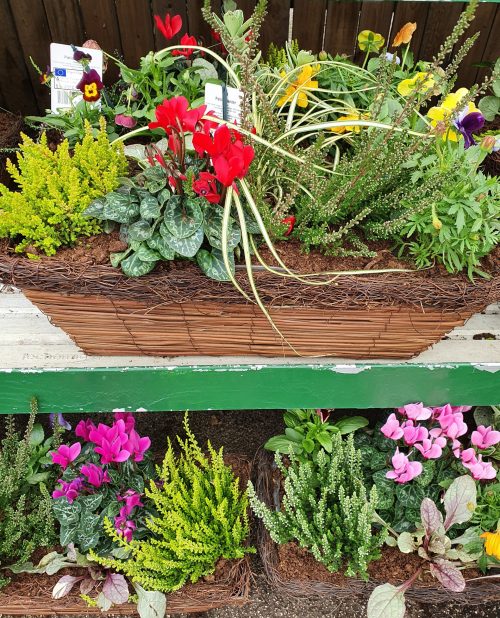
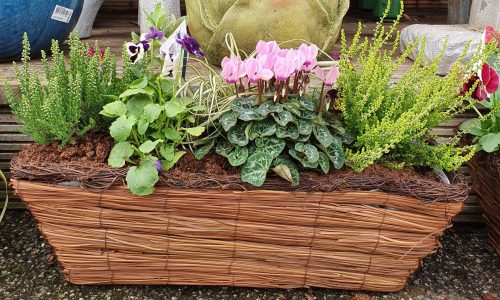 Patio Planter 53cm Window Box Wicker Position: Position planter outside in full natural light.When planted with summer bedding protect from frost. Plant care: Remove dead flower heads regularly to encourage new growth and blooms. Water/Feeding: Water the planter regularly and more frequently in hot or windy conditions.Feed on a regular basis with liquid fertilizer.
Patio Planter 53cm Window Box Wicker Position: Position planter outside in full natural light.When planted with summer bedding protect from frost. Plant care: Remove dead flower heads regularly to encourage new growth and blooms. Water/Feeding: Water the planter regularly and more frequently in hot or windy conditions.Feed on a regular basis with liquid fertilizer. -
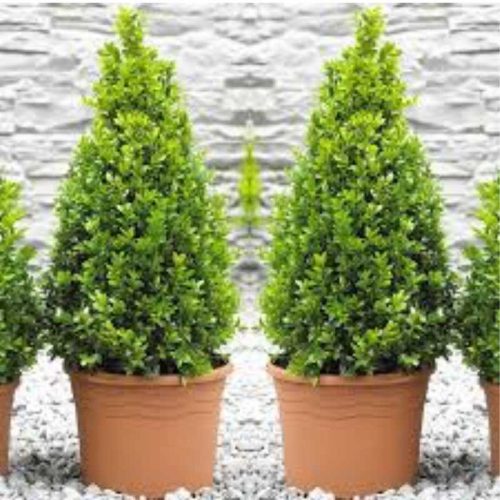
- Position: partial shade
- Soil: fertile, well-drained soil
- Rate of growth: slow-growing
- Hardiness: fully hardyA pair of these tightly clipped box spheres look great flanking a set of steps, a doorway or a path. One of our recommended plants, they're perfect for planting in a large terracotta pot in a partially shady site, where the glossy, dark-green leaves provide all year foliage, interest and structure. Box are happy growing in a sunnier spot, but the combination of dry soil and full sun may encourage poor growth and leaf scorching. If you have sandy soil it is best to keep them in a partially shady spot in the garden.
- Garden care: Ensure that the soil or compost is never allowed to dry out. Trim plants grown as hedges or topiary in mid- or late summer. If you want to maintain a really precise outline, then you can clip it twice a year - once in June, and then again in August/September. Apply a top-dressing of a balanced slow-release fertiliser such as blood, fish and bone (organic) or Growmore (inorganic) around the base of the plant in spring, making sure that none touches the leaves or stems.
-
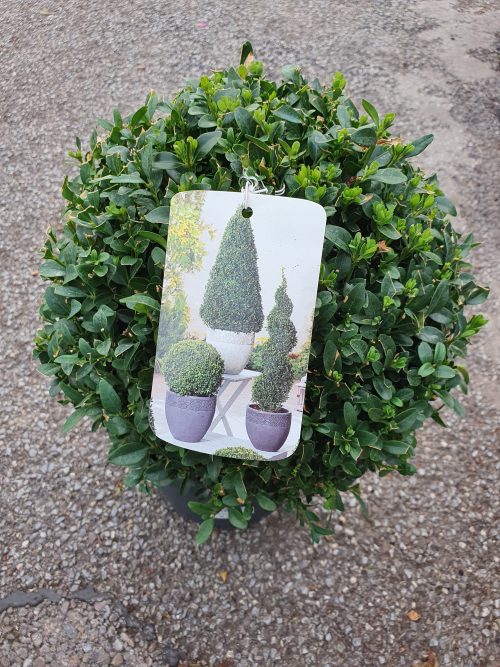
- Position: partial shade
- Soil: fertile, well-drained soil
- Rate of growth: slow-growing
- Hardiness: fully hardyA pair of these tightly clipped box spheres look great flanking a set of steps, a doorway or a path. One of our recommended plants, they're perfect for planting in a large terracotta pot in a partially shady site, where the glossy, dark-green leaves provide all year foliage, interest and structure. Box are happy growing in a sunnier spot, but the combination of dry soil and full sun may encourage poor growth and leaf scorching. If you have sandy soil it is best to keep them in a partially shady spot in the garden.
- Garden care: Ensure that the soil or compost is never allowed to dry out. Trim plants grown as hedges or topiary in mid- or late summer. If you want to maintain a really precise outline, then you can clip it twice a year - once in June, and then again in August/September. Apply a top-dressing of a balanced slow-release fertiliser such as blood, fish and bone (organic) or Growmore (inorganic) around the base of the plant in spring, making sure that none touches the leaves or stems.
-
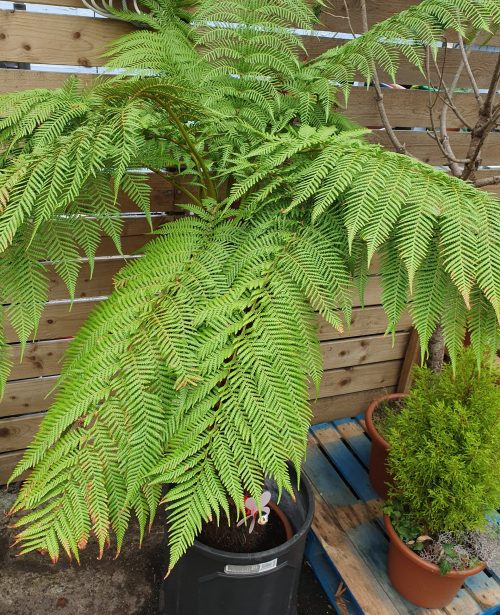
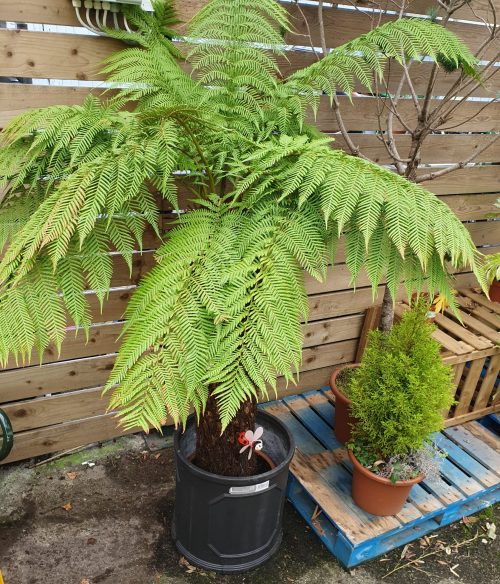 Native to coastal parts of Australia, Dicksonia antarctica is a magnificent, slow-growing, evergreen tree-fern (deciduous in colder areas) and one of the easiest to grow. The brown, fibrous ‘stem’ slowly grows taller, crowned by a rosette of beautiful, glossy, deep green fronds up to three metres long – a wonderfully architectural plant. Winter protection essential in all but the mildest areas – wrap the top of the ‘stem’ in fleece and protect the growing point in the crown with straw or similar insulation, and if pot-grown, bring inside or insulate the pot. Water the stem in hot weather; do not water the crown in winter. Site: Sheltered, sheltered coastal Soils: Moist but well-drained, acid to neutral soil Position: Partial shade or dappled shade Season of interest: Most of the year Hardiness: Frost-hardy Height to 13’ (4m) Spread to 13’ (4m)
Native to coastal parts of Australia, Dicksonia antarctica is a magnificent, slow-growing, evergreen tree-fern (deciduous in colder areas) and one of the easiest to grow. The brown, fibrous ‘stem’ slowly grows taller, crowned by a rosette of beautiful, glossy, deep green fronds up to three metres long – a wonderfully architectural plant. Winter protection essential in all but the mildest areas – wrap the top of the ‘stem’ in fleece and protect the growing point in the crown with straw or similar insulation, and if pot-grown, bring inside or insulate the pot. Water the stem in hot weather; do not water the crown in winter. Site: Sheltered, sheltered coastal Soils: Moist but well-drained, acid to neutral soil Position: Partial shade or dappled shade Season of interest: Most of the year Hardiness: Frost-hardy Height to 13’ (4m) Spread to 13’ (4m)
